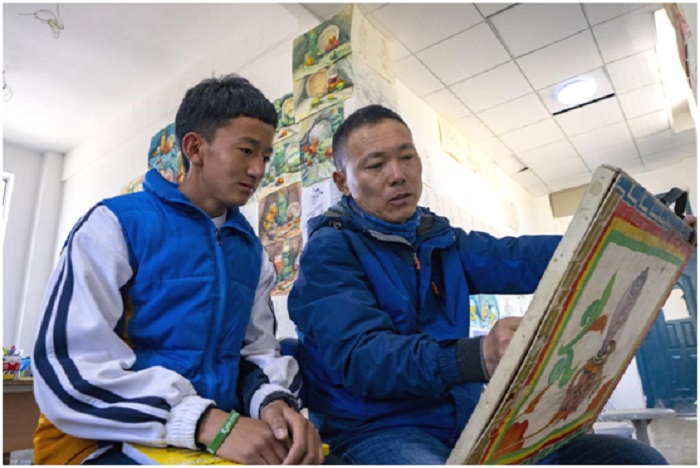



Fine art is bringing new possibilities to students in China’s Tibet autonomous region.
Thanks to Gao Qunbin, an art teacher from Shanghai volunteering to teach at the Shanghai Experimental School in Shigatse, southwest China’s Tibet autonomous region, several students of the school have passed the entrance exams for art academies this year and are ready to go to colleges, which had never happened in the school’s history.
In an activity room, extra-curricular fine art lessons are given by Gao at noon and evening every day and on each weekend.
However, the man was questioned a lot when he first started the classes.
“Can painting pay the bills?” That was a question he was always asked back then, because no one of the school had ever been admitted by a university through entrance exams for art academies, and most of the parents didn’t attach importance on art education.
“Art education is new to the people here,” Gao told People’s Daily, and that’s why he decided to seek students interested in fine art on his regular classes and recruit them for the extra-curricular lessons.
Padma Chungda was one of Gao’s earliest students. It was a fine art work of his with splendid coloring that attracted attention of Gao.
The students comes from Yadong county of Shigatse, a low-altitude county that boasts wide vegetation coverage. It is home to green mountains and lucid waters, as well as views of snow-capped mountains, which are all rare in Shigatse. Growing up in an environment like this, Padma Chungda are highly perceptive color-wise and is an expert of colors.
“Do you want to learn drawing? It earns you chances to enter colleges, or you can become an art teacher just like me,” Gao asked the student, seeing his talent.
What Gao said was quite tempting for Padma Chungda. After discussing with his family, he decided to join Gao’s extra-curricular courses and became one of the first fine art students of the latter in Shigatse.
Gao’s students learned well and fast. Padma Chungda, and the other two students attending Gao’s courses in the earliest days, all achieved great performance in the entrance examinations for art academies that year.
“They were the first students in Shigatse to pass the exams,” he said, adding that hard work forever pays, which is true to both himself and his students.
Just like pigments can make a glass of water colorful, Gao’s fine art classes have made school life more splendid for the students.
The success of Gao’s first students made him more confident when he explained art education to other parents. At present, over 20 senior high students are attending his extra-curricular fine art classes, and the number is higher in the school’s junior high department.
Preparing for further art studies in college, the students are also expanding the influence of art, Gao said.
Gao, who’s in his fifties and volunteering to teach in Tibet for a second time, has a goal to present the beauty of Shigatse to every student there and open a window into aesthetics for the children in mountainous areas.
“Art courses are a mirror of the school’s efforts in enhancing moral and art education. We have always been working to ensure that all students can find the extra-curricular activities they like,” said Zhang Bisheng, principal of the Shanghai Experimental School in Shigatse.
According to him, 52 student societies have been opened at the school by 28 teachers from Shanghai, who are trying their best to cover as many students as possible.


The Humanitarian Service Diamond Awards has.
A Chinese Company, Inner Galaxy Steel.


The Programme Coordinator, Regulatory, Compliance and.


A Non-Governmental Organization (NGO), Committee for.
The Trustfund Pensions Limited has chided.


The House of Representatives Committee on.
The China General Chamber of Commerce.


Senator Chuka Utazi who represented Enugu.


An Abuja based Legal Practitioner, Ugochukwu.


The African business community in Yiwu,.
Leave a Comment